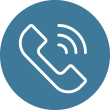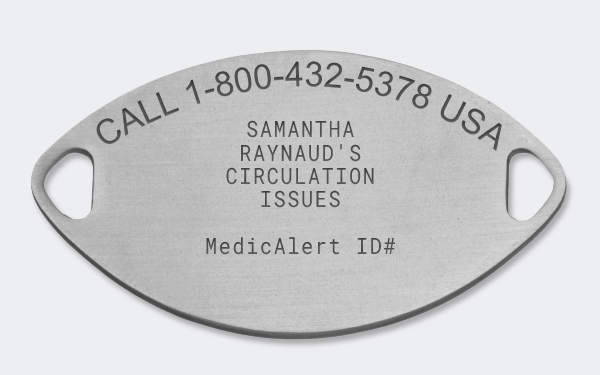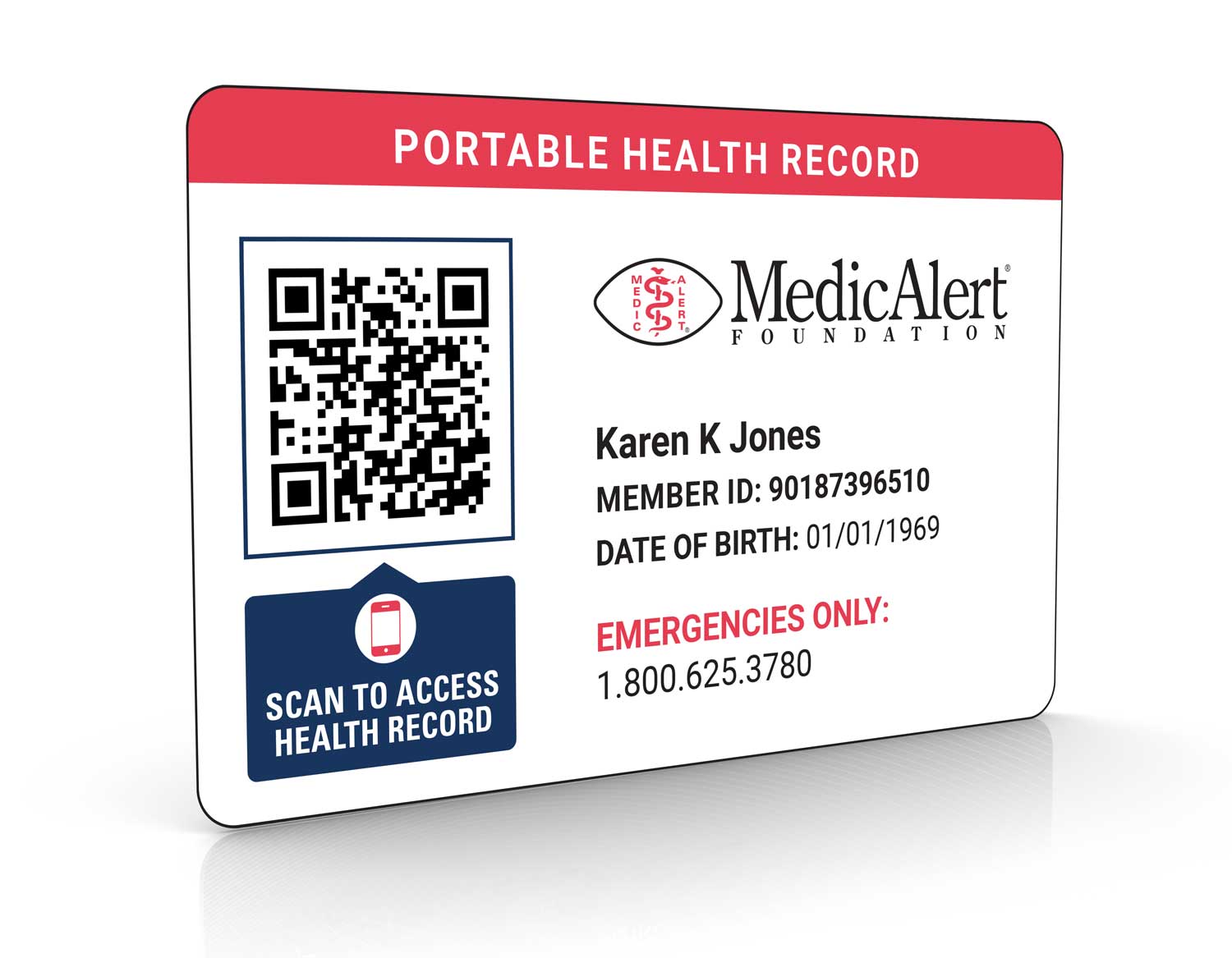Help others help you. Wear a medical alert ID bracelet or necklace engraved with important information for emergency responders and healthcare providers
Centers for Disease Control & Prevention

Medical IDs for Raynaud's syndrome
The confidence to live with Raynaud's syndrome
Raynaud’s syndrome is a health condition where the small blood vessels in a person’s fingers and toes spasm due to cold or stress. This spasm leads to temporary color changes in the fingers and toes, along with numbness, tingling, or throbbing.
In extreme cases, Raynaud’s can lead to serious tissue damage in the fingers and toes. Understanding how to manage and live with this illness will help you have a better quality of life and reduce your risk of complications.
That’s why a medical ID for Raynaud’s syndrome is critical for people living with the condition.
How MedicAlert protects those living with Raynaud's syndrome
One thing you shouldn’t worry about is what could happen if there’s an emergency. MedicAlert’s protection plans offer benefits that extend beyond the ID, providing safety and peace of mind for people living with Raynaud’s syndrome, their families and caregivers.

24/7 Emergency Response
Our team provides first responders the information they need to provide fast, accurate care.

Digital Health Profile
All your vital information, all in one place for you and your caregiver.

Emergency Contact Notification
In an emergency, we connect families so that no one is alone in a crisis.

Patient Instructions
Share the information that’s important to your care, such as use of rescue medications or contraindication for tests like MRIs.
Pair a medical ID for Raynaud’s syndrome with the protection plan that’s right for you.
What exactly is Raynaud’s syndrome?
Raynaud’s syndrome, also sometimes called Raynaud’s phenomenon or Raynaud’s disease, affects 5% of the United States population, 80% of whom are people assigned female at birth. It’s also more common in people over the age of 30, and those with a family history of Raynaud’s.
According to the National Institutes of Health, this condition causes blood vessels in the finger or toes to narrow (constrict) excessively. This happens in response to cold or stress. Sometimes, in rare cases, it can also affect the nose and ears.
There are two main types of Reynaud’s:
- Primary Raynaud’s– this is the most common form of Raynaud’s and isn’t caused by any other medical condition. The causes are not known.
- Secondary Raynaud’s– this is connected to another underlying problem. Smoking, lupus, rheumatoid arthritis, Sjogren’s syndrome, scleroderma, diseases of the arteries, carpal tunnel syndrome, injuries to the hands or feet, certain medications, and repetitive vibration or action affecting the fingers and toes have all been tied to Raynaud’s.
Although the terms Raynaud’s syndrome, disease, and phenomenon are all often used interchangeably, they actually refer to specific classifications of the condition:
- Raynaud’s disease– occurs on its own; primary Raynaud’s
- Raynaud’s phenomenon– is due to a secondary condition, medication, or lifestyle factor; secondary Raynaud’s
- Raynaud’s syndrome– an umbrella term for both types of Raynaud’s
What causes Raynaud’s syndrome?
Scientists understand that the symptoms of Raynaud’s are due to vasospasm of the arteries supplying blood to the fingers and toes. This vasospasm is a sudden narrowing of the blood vessels. In Raynaud’s, it is an abnormal response to cold or stress, and it can happen without a known cause or because of the effects of the underlying diseases discussed above, as well as medication use and smoking.
Common triggers of Raynaud’s episodes include:
- Sudden temperature changes, like walking into the frozen foods section of a store
- Stressful situations, anxiety, or even excitement
- Holding an ice-cold drink
- Sweat cooling on your skin
- Cold weather
- Reaching into the freezer for something
Of the diseases linked to Raynaud’s, there are a few that most commonly cause Raynaud’s symptoms:
- 90% of people with scleroderma have Raynaud’s
- 1 in 3 people with lupus have Raynaud’s
- There is a higher risk of Raynaud’s for people with autoimmune diseases and connective tissue diseases
- Pianists, keyboard operators, and those whose occupations require repetitive vibration like chainsaws and jackhammers, are also at higher risk of Raynaud’s
What to engrave on your MedicAlert medical ID for Raynaud's syndrome:
MedicAlert offers free custom engraving on all our medical ID products. Engravings on medical IDs for Raynaud’s syndrome should include any critical medical information that can protect and save lives in an accident or medical emergency, for example:
- Medical history, including any conditions related to Raynaud’s
- Medications
- Allergies
- Any other important details that need to be easily visible for first responders

Sample engraving. Consult our team if you need help engraving your medical ID for Raynaud’s syndrome.
What are the symptoms and complications of Raynaud’s syndrome?
The symptoms of Raynaud’s syndrome come and go. When a person has symptoms it is called an attack, and they will notice the following:
- Cold or numb fingers and toes– this can feel like the body part affected has fallen asleep
- Color changes- at first, skin color may look white or blue; as blood flow returns when the attack ends, it may turn red
- Warmth, tingling, and throbbing- this symptom is also part of blood flow returning after an attack
Raynaud’s attacks usually last around 15 minutes, but they can be longer or shorter. Secondary Raynaud’s usually causes more severe symptoms. The most serious complication of Raynaud’s is sores called ulcers forming on the fingertips. These sores can develop gangrene (tissue death), leading in rare cases to amputation.
How do you treat Raynaud’s syndrome?
In many cases, treating Raynaud’s involves lifestyle modifications. Quitting smoking, avoiding stress, avoiding the cold, and keeping warm can all help reduce symptoms. Warm gloves and hand warmers can help, along with keeping your core warm.
If changing habits doesn’t help reduce the frequency of episodes, medications can be added. These include certain types of blood pressure medications, cholesterol-lowering medications (statins), selective serotonin reuptake inhibitors (SSRIs), and topical creams. For severe cases, the medication sildenafil or prostacyclins can be used.
If you notice sores developing on your fingers, it’s important to let your doctor know right away so more serious complications can be avoided.

MedicAlert Foundation is proud to partner with NORD to provide support, educational resources and tools to help those affected by rare disease live more safely and confidently.
How do you diagnose Raynaud’s syndrome?
To diagnose Raynaud’s, doctors consider a patient’s medical history and physical exam. Blood tests can be done to look for conditions that cause secondary Raynaud’s. And in some cases, doctors perform an ice water or cold immersion test, which can help confirm what the person is describing.
This combination of symptoms, history, and sometimes, having a condition that is known to be frequently linked to Raynaud’s, can all help your doctor reach a reliable diagnosis.
How medical IDs for Raynaud's syndrome combined with MedicAlert Membership provide peace of mind
Understanding a Raynaud’s diagnosis, managing your lifestyle to control the symptoms, and following your doctor’s treatment recommendations can help improve your quality of life. By adding a MedicAlert ID to your care strategies, you can have the additional peace of mind of knowing you’re protected in any emergency that could arise.
- We’re your voice: If you can’t speak for yourself due to a medical emergency, your ID will speak for you – informing others about your Raynaud’s syndrome and any medications you’re taking.
- 24/7 emergency protection: In an emergency, the MedicAlert team will relay all of your critical medical information to first responders, no matter where or when your emergency happens.
- Always connected: You should never be alone in an emergency. That’s why MedicAlert will reach out to your designated contacts if you are unable to do so.
- Live with peace of mind and confidence: MedicAlert will be there for you every step of the way. You’ll have the confidence and freedom to live your life with Raynaud’s syndrome, knowing we’ve got you covered.
DISCLAIMER: THIS WEBSITE DOES NOT PROVIDE MEDICAL ADVICE. The information in this article is presented for educational purposes only and is not intended as a substitute for professional medical advice, diagnosis and treatment. Always seek the advice of a physician or other qualified healthcare provider for any questions you may have regarding a medical condition or treatment.







